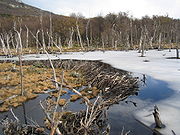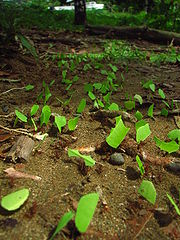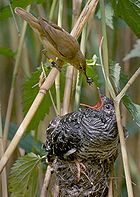
Niche construction
Encyclopedia

Organism
In biology, an organism is any contiguous living system . In at least some form, all organisms are capable of response to stimuli, reproduction, growth and development, and maintenance of homoeostasis as a stable whole.An organism may either be unicellular or, as in the case of humans, comprise...
alters its own (or other species') environment
Natural environment
The natural environment encompasses all living and non-living things occurring naturally on Earth or some region thereof. It is an environment that encompasses the interaction of all living species....
, often but not always in a manner that increases its chances of survival. Several biologist
Biologist
A biologist is a scientist devoted to and producing results in biology through the study of life. Typically biologists study organisms and their relationship to their environment. Biologists involved in basic research attempt to discover underlying mechanisms that govern how organisms work...
s have argued that niche construction is as important to evolution as natural selection
Natural selection
Natural selection is the nonrandom process by which biologic traits become either more or less common in a population as a function of differential reproduction of their bearers. It is a key mechanism of evolution....
(i.e., not only does an environment cause changes in species
Species
In biology, a species is one of the basic units of biological classification and a taxonomic rank. A species is often defined as a group of organisms capable of interbreeding and producing fertile offspring. While in many cases this definition is adequate, more precise or differing measures are...
through selection, but species also cause changes in their environment through niche construction). This creates a feedback relationship between natural selection and niche-construction; with organisms affecting their environment. That change then causes a shift in what traits are being naturally selected for. The effect of niche construction is especially pronounced in situations where environmental alterations persist for several generations, introducing the evolutionary role of ecological inheritance. Less drastic niche-constructing behaviors are also quite possible for an organism. This theory, in conjunction with natural selection, shows that organisms inherit two legacies from their ancestors, genes and a modified environment. Together, these two evolutionary mechanisms determine a population's fitness and what adaptations those organisms develop in the continuation for their survival.
Examples

- EarthwormEarthwormEarthworm is the common name for the largest members of Oligochaeta in the phylum Annelida. In classical systems they were placed in the order Opisthopora, on the basis of the male pores opening posterior to the female pores, even though the internal male segments are anterior to the female...
s: Through a process of modification, earthworms chemically alter the soil in which they live. This change in soil chemistry stimulates an increased fitness in earthworm populations. The subsequent chemical composition of soil produced by earthworm activity also benefits the growth of proximal species of plants and other biota present in the soil. - Lemon Ants (Myrmelachista schumanniMyrmelachista schumanniMyrmelachista schumanni, also known as the lemon ant, is a species of ant that is notable for the creation of Devil's garden. Using its own herbicide, it is able to shape its surroundings....
): This species of ants employs a specialized method of suppression that regulates the growth of certain trees. Lemon ants make their homes in the bodies of Duroia hirsutaDuroia hirsutaDuroia hirsuta is a myrmecophyte tree species from the Amazon Forest. It is one of some 37 species of Duroia which are shrubs or canopy trees in the family Rubiaceae, favouring ants , and occurring in Central America as far north as Mexico, the Amazon Basin, the Guiana Shield, the Brazilian...
, a species of tree found in the Amazonian rainforest of Peru. To ensure the prevalence of Duroia trees, Lemon ants employ self-derived quantities of formic acid (a chemical fairly common among species of ants) as a tenacious herbicide. The end result alters the composition of their forest habitat drastically by wiping out arboreal species ill-suited for colony habitation. When observed by humans, the subsequent altered ecologies perpetuated by these ants have been termed the Devil's GardensDevil's gardenThis should not be confused with the Devil's gardensIn myrmecology and forest ecology, a devil's garden is a large stand of trees in the Amazon Rainforest consisting almost exclusively of a single species, Duroia hirsuta...
. - Leafcutter Ants (AttaAttaAtta is a genus of New World ants of the subfamily Myrmicinae. It contains at least 16 known species.Leaf-cutter ants are relatively large, rusty red or brown in colour, and have a spiny body and long legs. There are three main castes within a nest: the queen, worker and soldier. Only the queens...
): Leaf cutter ants, related distantly to the Lemon Ants, also share a relationship with plants that makes their niche unique. Native to the tropical regions of the North and South America, this species harvests foliage from surrounding broadleaf plants outside their nests and drag them down to specialized chambers. In these chambers, the leaves are used as source of nutrition for a family of fungi known as Lepiotaceae. They form a symbiotic relationship with the fungus: the ants feed and groom the fungus, keeping it safe from pests, and in turn the fungus provides food for the queen and other members of the colony. There are currently sixteen individual species recognized by scientists, and are the only species known to occupy this niche. - BeaverBeaverThe beaver is a primarily nocturnal, large, semi-aquatic rodent. Castor includes two extant species, North American Beaver and Eurasian Beaver . Beavers are known for building dams, canals, and lodges . They are the second-largest rodent in the world...
s: In the construction of their dams, beavers drastically shape and alter the ecosystem in which they live. Deforestation, effects on soil structure, root structure, turbidity of water, allocation of water and the supply of water downstream are just a handful of exemplars defining beaver niche construction. Beavers express a clear example of the diverse effects perpetuated by the construction of a niche. In the mammalian kingdom beavers are one of the greatest proximal modifiers. - Diatoms in the Bay of Fundy, Canada, provide another example of an ecosystem engineer. Benthic diatoms living in estuarine sediments secrete carbohydrate exudates that bind the sand and stabilize the environment. The diatoms cause a physical state change in the properties of the sand that allows other organisms to colonize the area. The concept of ecosystem engineering brings new conceptual implications for the discipline of conservation biologyConservation biologyConservation biology is the scientific study of the nature and status of Earth's biodiversity with the aim of protecting species, their habitats, and ecosystems from excessive rates of extinction...
. - Pine TreesPinePines are trees in the genus Pinus ,in the family Pinaceae. They make up the monotypic subfamily Pinoideae. There are about 115 species of pine, although different authorities accept between 105 and 125 species.-Etymology:...
& Chaparrals: Chaparrals and pines have been found to express niche constructing behaviorBehaviorBehavior or behaviour refers to the actions and mannerisms made by organisms, systems, or artificial entities in conjunction with its environment, which includes the other systems or organisms around as well as the physical environment...
in response to the effects of forest fire. These trees and shrubs increase the frequency of fire by affecting the composition of the forest floor. They achieve this end through the dispersal of needles, cones, seeds and oils, essentially littering the forest floor. The benefit of this activity is compounded by an adaptation in these particular flora that has selected for a resistance to fire. The evolutionary exchange (made between both niche construction and natural selection) allows the fire-resistant pine and chaparral to exploit the chemical change that occurs in soil after organic matter has been burned. - Humans: See subsection below.
Implications
Niche construction has many implications for the human sciences, more specifically human sociobiologySociobiology
Sociobiology is a field of scientific study which is based on the assumption that social behavior has resulted from evolution and attempts to explain and examine social behavior within that context. Often considered a branch of biology and sociology, it also draws from ethology, anthropology,...
, evolutionary psychology
Evolutionary psychology
Evolutionary psychology is an approach in the social and natural sciences that examines psychological traits such as memory, perception, and language from a modern evolutionary perspective. It seeks to identify which human psychological traits are evolved adaptations, that is, the functional...
, and human behavioral ecology
Human behavioral ecology
Human behavioral ecology or human evolutionary ecology applies the principles of evolutionary theory and optimization to the study of human behavioral and cultural diversity. HBE examines the adaptive design of traits, behaviors, and life histories of humans in an ecological context...
. Standard evolutionary theory only allows for cultural processes to affect genetic evolution by influencing the individual, and depends on the ability of that individual to survive and pass on its genes to the next generation. Cultural processes are viewed merely as an aspect of the human phenotype
Phenotype
A phenotype is an organism's observable characteristics or traits: such as its morphology, development, biochemical or physiological properties, behavior, and products of behavior...
and are not believed to be consequential to human evolution. Cultural diversity is believed to reflect variation in the environments that different populations of humans evolved in, and nothing else. This theory overlooks the fact that humans can modify their selective environments through cultural activity, thus feeding back to affect selection. "Cultural processes add a second knowledge inheritance system to the evolutionary process through which socially learned information is accrued, stored, and transmitted between individuals both within and between generations."
With the addition of language to the human culture came an increased mental capacity. This allowed for human adaptation of the environment to be a learned process, unlike nonhuman species, whose adaptive process is instinctual. This resulted in the acceleration of environmental, behavioral and genetic modifications. As niche construction advocate Derek Bickerton writes, "We could construct our niches without having to wait on interminable rounds of feedback between genes and behavior."
A theory on gene-culture coevolution calls for a more integrated relationship between genetic evolution and cultural processes than standard evolutionary theory. In this model, cultural activities are believed to affect the evolutionary process by modifying selection pressures. In other words, cultural change has the capacity to codirect its population's genetic evolution. Mathematical and conceptual models including investigations of language, handedness, the emergence of incest taboos, the coevolution of hereditary deafness and sign language, and sexual selection with a culturally transmitted mating preference demonstrate this theory. However, this theory is still dependent on standard evolutionary theory because it requires that cultural processes only affect genes directly, not allowing for any intermediate factors in the environment to interact with these processes at an evolutionary level. This theory exists on a dual inheritance system consisting solely of genes and cultural activity. "The dual inheritance system is a way to include interactions between nature and nurture in a tractable system." In most cases this theory works smoothly, however there are instances where cultural activities create changes in the abiotic environment that then affect selection pressures.
The speed at which humans are able to construct niches modifies the selection pressures and either genetic evolution or further niche construction can result. An example of genetic evolution through niche construction with the inclusion of an abiotic factor: Yam cultivators in West Africa cut clearings in forests to grow crops, but resulted in much standing water which attracted mosquitoes and increased the rate of malaria. This caused a modification to the selection pressure for the sickle-cell allele that protects against malaria. Evolutionary change is thus furthered. Example of further niche construction: Humans change the environment through pollution. The effects of pollution are alleviated by the innovation and use of a new technology. This cultural response to a constructed niche allows for a change in environment and a lack of change in genetics. Only if a new technology is not created or effective will evolutionary change occur. Humans are able to sustain adaptiveness by responding to ancestral niche construction through further cultural niche construction.
The addition of niche construction to the study of evolutionary processes forces scientists to accept that cultural activity is not the reason that humans are able to modify their environments, but is simply their primary means of doing the same thing that other species do. The fact that a large number of cultural processes are learned rather than genetically encoded into the individual, makes human culture an incredibly powerful method of niche construction. "Most of the time, cultural processes can be regarded as a shortcut to acquiring adaptive information, as individuals rapidly learn, or are shown, what to eat, where to live, or how to avoid danger by doing what other more knowledgeable individuals do."
Consequences

Another consequence is that they can affect natural selection pressures put on a species. The common cuckoo
Common Cuckoo
The Common Cuckoo is a member of the cuckoo order of birds, Cuculiformes, which includes the roadrunners, the anis and the coucals....
bird is an excellent example of such a consequence. This species of bird parasites other birds by laying their eggs in the other species nest. This had led to several adaptations among the cuckoo’s, one of which is a short incubation time for their eggs. The eggs need to hatch first so that the chick can push the other species' eggs out of the nest, ensuring it has no competition for the parent attention. Another adaptation it has acquired is that the chick mimics the calls of multiple young chicks, so that the parents are bringing in food not just for one offspring, but a whole brood.
External links
- http://www.nicheconstruction.com/
- Day RL, Laland KN, Odling-Smee FJ Perspect Biol Med. 46:80-95 (2003) Rethinking adaptation: the niche-construction perspective
- Laland K. N., Odling-Smee J. & Feldman M. W. Proc. Natl Acad. Sci. USA 96, 10242-10247 (1999). Evolutionary consequences of niche construction and their implications for ecology

